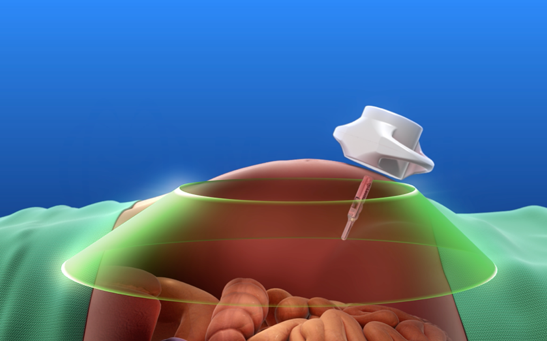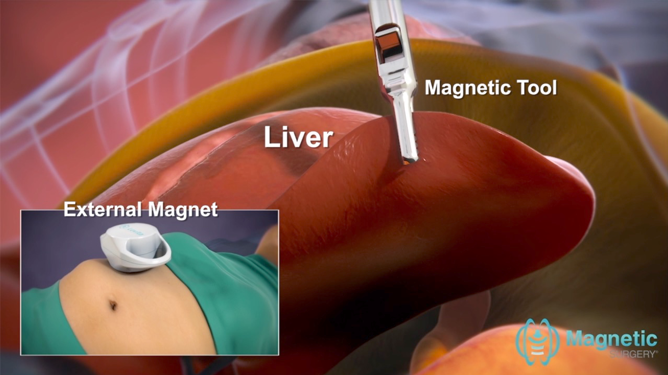Magnetic Surgery
What is minimally invasive surgery?
In minimally invasive surgery, doctors use a variety of techniques to operate with less damage to the body than with open surgery. In general, minimally invasive surgery is associated with less pain, a shorter hospital stay and fewer complications.*
Laparoscopy — surgery done through one or more small incisions, using small tubes and tiny cameras and surgical instruments — was one of the first types of minimally invasive surgery.
Surgeons perform many minimally invasive surgeries, including, but not limited to:
- Gallbladder surgery (cholecystectomy) to remove gallstones that cause pain
- Bariatric or weight loss surgery
- Prostate removal (prostatectomy)
*Source: https://www.mayoclinic.org/tests-procedures/minimally-invasive-surgery/about/pac-20384771
What is Magnetic Surgery?
Magnetic Surgery® is the next evolution of minimally invasive surgery making it possible for surgeons to perform certain surgeries with even fewer incisions.1-4
Traditional Surgery:
In traditional laparoscopic surgery, each surgical tool is manipulated through a dedicated tube (trocar), inserted through its own abdominal incision, with limited range of motion.

Each surgical tool requires a dedicated tube and incision, limiting range of motion
Magnetic Surgery:
Magnetic Surgery is designed to address the limitations of traditional surgical tools. In Magnetic Surgery, a magnetic tool, or retractor, is controlled by an external magnet outside the patient’s body.

Surgical tools move freely, reducing number of incisions and providing a clear view of surgical field
Benefits of Magnetic Surgery

Eliminate an abdominal incision and tube (trocar)
Incisions and trocars are associated with risks including major bowel and vessel injury, incisional pain, infections, bleeding, scarring and hernias.

Less scarring after surgery.
This is due to fewer incisions.

Quick return to normal activities.
In a 50-patient study, among the 33 patients who worked, the average time to return to work was within 5 days of Magnetic Surgery.3

Patients would do it again.
In a 50-patient study, 48 said they would have the Magnetic Surgery procedure again.4
Magnetic Surgery is available for various surgical applications, specifically:
- Bariatric (weight loss) surgery, such as gastric bypass, sleeve gastrectomy, and duodenal switch procedures
- Cholecystectomy (gallbladder removal)
- Prostatectomy (prostate removal)
How does Magnetic Surgery work in weight loss (bariatric) procedures?
- Access is gained to the abdominal area via surgical ports, inserted through incisions. In traditional laparoscopic surgery, a tool is typically inserted through the epigastric incision, just below the ribcage, to lift the liver for access to the stomach. This incision is associated with postoperative pain, interferes with a woman’s bra strap during recovery and results in visible scarring. The epigastric incision is eliminated with Magnetic Surgery.

The epigastric incision just below the ribcage is eliminated with Magnetic Surgery
- A shaftless magnetic tool (retractor) is used to retract the liver, controlled by an external magnet on the skin outside the body.

Magnetic Surgery used to retract liver in bariatric procedures
How does Magnetic Surgery work in cholecystecomy (gallbladder removal) procedures?
Magnetic Surgery is used to retract the gallbladder, which enables one less incision and tube (trocar) to be used during gallbladder removal surgeries.
Magnetic Surgery used to retract gallbladder
How does Magnetic Surgery work in prostatectomy (prostate removal) procedures?
Magnetic Surgery is used to retract the prostate and periprostatic (surrounding) tissue, while reducing the number of tubes (trocars) and incisions required.
Retraction is performed to facilitate your surgeon’s ability to access and see the surgical field helping preserve sexual function and urinary continence.
Magnetic Surgery used to retract prostate
The Levita Magnetic Surgical System is indicated in the U.S. to grasp and retract the body and the fundus of the gallbladder in laparoscopic cholecystectomy procedures, the liver in bariatric procedures and the prostate and periprostatic tissue in prostatectomy procedures to facilitate access and visualization of the surgical site in patients with a body mass index (BMI) of 20 to 60 kg/m2.
As with any surgery, there are risks associated with Magnetic Surgery procedures, including infection, injury to tissue and/or abdominal wall, or the need for extended or additional surgery. In clinical trials, the only risk experienced was mild bruising (petechiae). Magnetic surgery procedures are contraindicated for patients with pacemakers, defibrillation, other electromedical implants and/or ferromagnetic implants. Consult your physician to discuss the risks and benefits to determine if Magnetic Surgery is right for you.
For clinical data on Magnetic Surgery, see:
- Haskins, et al. Surg Endosc (2018) 32: 895. Magnetic surgery: first U.S. experience with a novel https://www.ncbi.nlm.nih.gov/pubmed/28733750
- Rivas H, et al. Magnetic Surgery: Results From First Prospective Clinical Trial in 50 Patients. Annals of Surgery, January 2018,267(1):88-93. https://www.ncbi.nlm.nih.gov/pubmed/27759614
- Davis M, et al. Magnetic Liver Retraction: an Incision-Less Approach for Less Invasive Bariatric Surgery, March 2019. 2019 Mar;29(3):1068-1073. https://www.ncbi.nlm.nih.gov/pubmed/30604079
- Gettman M. Late-Breaking Abstract: First Clinical Evaluation of a Novel Magnetic Retraction Device during Reduced Port Robotic Assisted Radical Prostatectomy (ClinicalTrials.gov NCT03624465) AUA 2019 Plenary Presentation (Plenary: Next Frontier). https://www.eventscribe.com/2019/AUA2019/fsPopup.asp?efp=VVZOVkFJT042MDYx&PresentationID=517983&rnd=0.4028432&mode=presinfo
- Luengas R. et al. Abstract: First Prospective Clinical Trial of a Novel Magnetic Retraction Device During Reduced Port Bariatric Surgery (Clinicaltrials.gov NCT03508674) <link to presentation> ASMBS Obesity Week 2019 ePoster presentation.
- Berry M. et al. Abstract: Magnetic Grasper Technology for Laparoscopic Gastric Sleeve Surgery <link to presentation> ASMBS Obesity Week 2019 ePoster presentation.
MKT1526, Rev. A